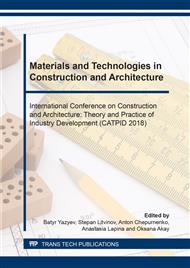p.174
p.178
p.184
p.188
p.196
p.200
p.209
p.214
p.219
The Influence of the Characteristics of the Structural System on the Results of the Calculation of High-Rise Building on Seismic Action
Abstract:
This paper presents the results of the simulation experiment performed in Lira-SAPR. The purpose of the experiment is modal analysis of various structural schemes of the high-rise reinforced concrete frame under pulsation and earthquake action. Calculations have been made for three series of samples, differing in the stiffness ratio of the frame and diaphragm of the scheme (from 20% to 65.9%), considering seismic rating of 7, 8 and 9 magnitude and subsoils of the 1st, 2nd and 3rd categories of seismic activity. It has been established, that the ratio of stiffness influences the distribution of the modal mass. The acceleration of the cover nodes does not depend on the stiffness ratio – they grow as seismic activity of the site increases. Stiffness ratio influences the total reinforcement requirement. This influence is significant in the range of ratio values from 20.5% to 42.5%. Further increase in the stiffness ratio has little influence on the reinforcement requirement.
Info:
Periodical:
Pages:
196-199
Citation:
Online since:
September 2018
Authors:
Price:
Сopyright:
© 2018 Trans Tech Publications Ltd. All Rights Reserved
Share:
Citation:


